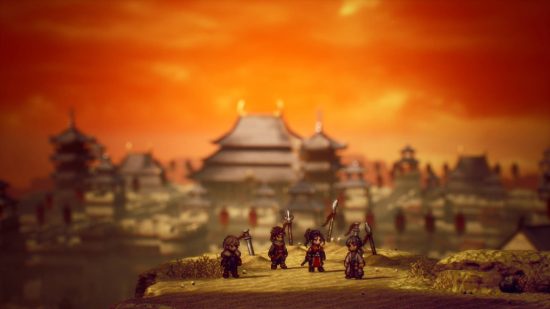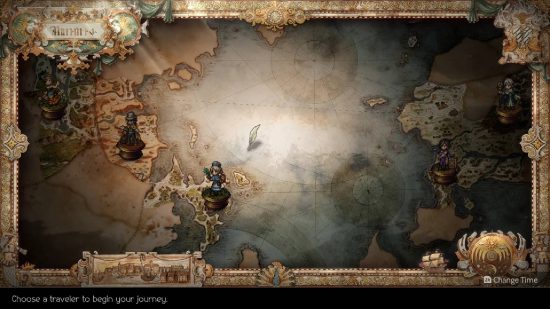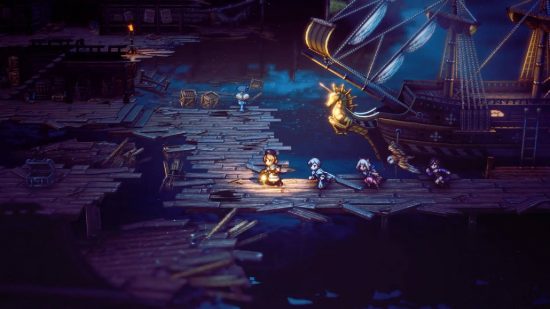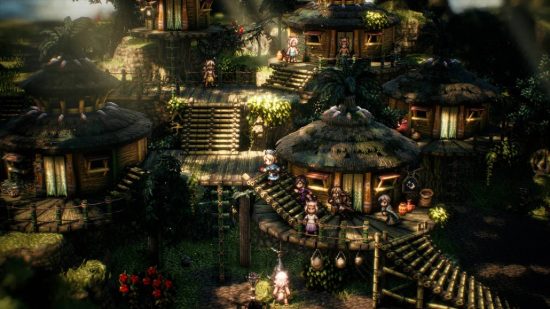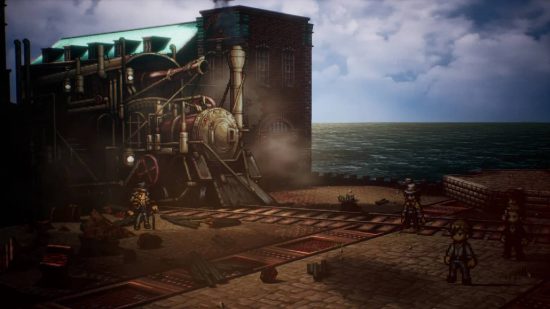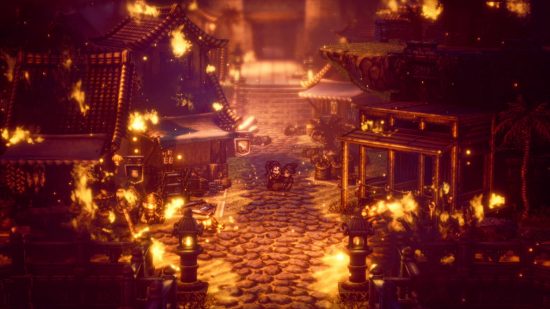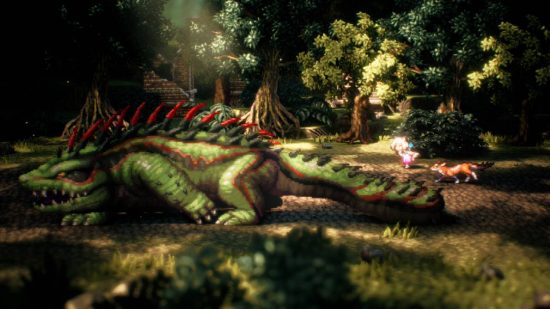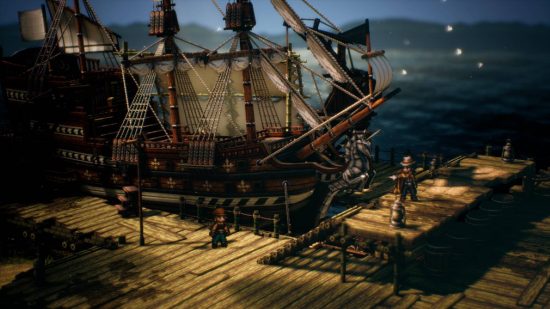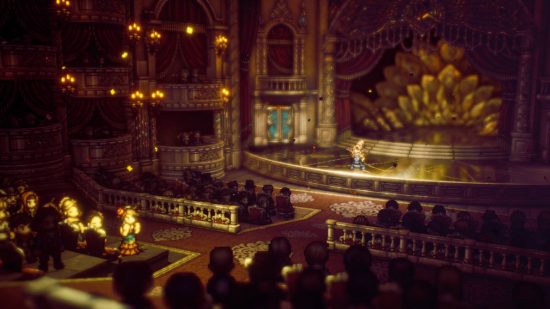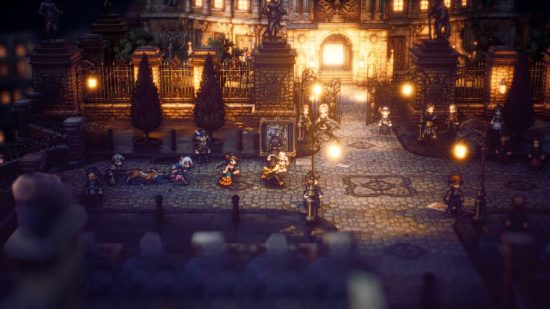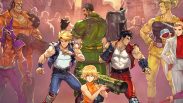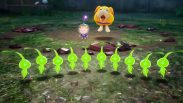Square Enix’s art style, known as HD-2D, is one of my favourite innovations in modern gaming. As a blend of pixelated characters and 3D environments, it evokes the spirit of classic JRPGs like Chrono Trigger, Final Fantasy VI, and Dragon Quest III; while still letting Square Enix create gorgeous worlds that showcase the graphical potential of the Nintendo Switch.
The original herald of this style is Octopath Traveler, a 2018 release for Nintendo Switch and a traditional JRPG in every sense. Following the stories of eight different characters, the original Octopath features intertwining stories over a large continent as each person’s narrative takes them to the far reaches of the world. It also has turn-based combat with an interesting ‘break’ mechanic that allows you to bank or use more powerful attacks.
Well, we all know Square Enix loves a sequel, and here we are years on, with the release of Octopath Traveller II. The next HD-2D entry from the Japanese publisher after last year’s Triangle Strategy and Live A Live remake, OTII takes you back to the classic JRPG adventures of old. But, with a brand new cast of eight characters to get to know and love.
First of all, full disclosure, we haven’t had time to get to the ending of Octopath Traveler II. This is a long, long, game. We’ve poured just over sixty hours into the title over a couple of weeks, but please look forward to a full article on the ending in the future. The ending of the original Octopath Traveler brings all of the storylines together, and we want to discuss the ending of the sequel compared to that. But, rest assured, we’ve played more than enough to give an opinion, and have seen a huge amount of what this game has to offer.
Set in the vast world of Solistia, Octopath Traveler II allows you to explore a gorgeous and meticulously detailed world with a nice variety of vistas. I chose to start with Hikari, a young warrior from the land of Ku, who’s courageous with enviable skills in battle. After around 60 hours, I’m familiar with each of the main cast’s stories, and I highly recommend you begin with Hikari. The variety of tales are great, and each feels more interesting than in Octopath Traveler, but Hikari is the most gripping and fun in my experience.
It doesn’t matter too much, as no matter who you choose, you soon get to explore the world at large with a motley crew of adventurers, each looking to find someone or something in the world to help their own story. The cast includes Partitio the merchant, a man obsessed with commerce, out to prove his skills to the world.
There’s the thief Throné, stuck in a world of criminals and low lives, looking to escape. Meanwhile, another standout is Temenos, a sassy cleric with an eye for details out so solve a mystery and clear his name. Plus, if you played the original, you may notice the same jobs are on offer here, but each has different skills this time around, helping to keep things fresh and interesting.
Whichever character you choose jumpstarts the story, and then you pick up additional party members as you encounter them on your travels. You can choose to hear their tale and experience their story so far, which stops your current party in their tracks as you play as the new hero at level one, getting to grips with their tale and skills. However, in an effort to speed up the opening hours, there’s the ability to skip their story and simply carry on the adventures of your current party. Don’t worry about missing anything, as the local taverns always offer the chance to experience these opening stories again any time you choose.
These stories have a nice mixture of peril, epic clashes, and more whimsical moments that round out the cast nicely. Each story features the same turn-based combat as the others, but the variety of jobs, skills, and weapons are enough to keep you on your toes and teach you about the game’s many mechanics. Now, such is the way while juggling eight different stories, some fair better than others. I find myself dragging my feet at certain points, having to include a couple of party members and continuing their stories.
I don’t really enjoy the stories of Castti, the apothecary, or Agnea, the dancer. Castti’s story in particular runs through a fairly typical plot, as she loses her memory and must find clues across the kingdom to discover more about herself. Sadly, the character is just a bit lifeless and I avoid the storylines featuring her. Agnea at least has a bit more life to her, being a spirited dancer with some charm, but that story is also somewhat dull.
But, when the narrative works, it’s phenomenal. The opening two chapters of Osvald’s story are perhaps better than anything else in the original Octopath Traveler or the sequel. Temenos is a fantastic character I’m in love with, thanks to sharp writing and fantastic voice acting. Meanwhile, the optimism and charm of Ochette are infectious, and her beast-heavy story is a joy to experience. With eight stories to get through, some can’t be as good as others, but the overall strength of the narratives, the voice acting, and even the characters themselves feel like a marked improvement over the original.
While the visuals and story are the defining features, Octopath Traveler II is also home to some gripping turn-based combat and the battles are a blast thanks to the gorgeous pixelated style and beautiful particle effects. Each enemy has a series of physical and elemental weaknesses, and a shot to one of those weaknesses exposes them forever in a box below that enemy. Striking their weakness repeatedly eventually breaks their shield. Some enemies take one hit, while stronger ones withstand many more.
Break an enemy’s shield and you stun them, meaning they’re more vulnerable than normal. This is also a fantastic time to use your boost points, which accumulate with each turn. Entering boost mode multiplies your attack power up to four times, so there’s a delicate balance in deciding when to bank your points and when to use them. For anyone familiar with the original title, none of this is new. However, the battles in the original Octopath Traveler are a huge highlight, so there’s little surprise they remain largely intact.
Another returning feature is secondary jobs, as each character eventually unlocks the ability to take on a secondary role, giving them access to new weapons, skills, and more. This is in addition to their main role, so my warrior Hikari is also an inventor at the moment, giving him access to a few fun new twists in battle. As you gain experience, you also earn JP to learn new jobs and support skills, meaning characters don’t just get stronger but also learn a wider variety of battle tactics. So, you can equip Osvald the scholar with the merchant secondary job, and soon utilise the merchant skill ‘grows on trees’, so you can earn extra cash even when Partitio isn’t in your party.
A new addition is latent powers. While you can hot-swap jobs, equipment, and skills, each character has a latent power unique to them. These abilities charge up when characters take damage, ready for you to unleash them in battle. For instance, Throné’s power allows her to act a second time in battle, while Temenos’ allows him to lower the enemy’s shield points regardless of the weapon used. It’s another interesting wrinkle to combat, and a nice touch of personality for each character. Plus, latent power carries over between battles, so you can charge it up before a boss if you please, giving you a nice advantage.
The depth and breadth of different jobs, weapons, and skills are all a blast to play around with. Plus, a truly gross crew of enemies are fun to work your way through, including some fantastic larger enemies and a few grotesque bosses. The pixel art is phenomenal, just like the first game’s, and the larger enemies are where it’s most proudly on display. The later chapters feature some amazing boss fights with incredible art, and just like the first title it only gets wilder as time goes on.
Battles also look fantastic, as the HD-2D style is prettier this time around. More dynamic camera angles, a wider variety of poses for characters, and a steady stream of particle effects mean that this pixelated world feels more alive than some fully 3D adventures. Square also improved town exploration, as the aforementioned camera angles are a step forward for the sometimes stiff angles of the original Octopath. This is an absolutely gorgeous game, and given the improvements to the HD-2D style from the predecessor, I’m already greedily imagining where Square Enix takes this style in the future. That Dragon Quest 3 remake can’t come soon enough.
Speaking of exploring towns, each member of your party is capable of different skills called path actions, which change how you interact with NPCs in each area. Throné is a thief, so is able to steal items from folks, though a failure does cause you to lose your reputation in that town. Hikari is a warrior, so can challenge stubborn townsfolks to a duel, with a victory knocking them out of the way and possibly revealing an additional path. Meanwhile, Agnea can allure NPCs into battle with your party, convincing them to join you in fights. Unlike the first Octopath Traveler though, each character has a different path action at night, opening up your party to even more possible character interactions.
This litany of different skills makes it a joy to explore each new area while also making it a strategic minefield trying to balance your party both in battle skills and overworld abilities. Luckily there seems to be a good balance no matter who you choose, but narrowing your eight characters down to a party of four is a struggle once you have a few favourites. There seems to be much more voice acting this time around as well (and of a higher quality), making it even easier to fall in love with each hero.
The world of Octopath Traveler, the stories, and the interactions are an improvement over the first. The land of Solistia is full of a large variety of different nations and locations, each with an interesting presentation and new enemies to defeat. The stories themselves each have some really fun twists and turns, and I can’t speak enough about the quality of both the presentation and the voice acting this time around. Octopath Traveler feels more dynamic, more interesting, and more alive, compared to its predecessor.
In particular, the way Partitio interacts with the world, and the changes his stories make to it, are so satisfying. The merchant sniffs out commerce across the map, and it adds some really fun features to the title, including a customisable ship which allows you to explore the open ocean. I love Octopath Traveler, but it eventually felt like a grind and a chore to complete. Some sixty hours into the sequel, I’m still completely addicted and discovering new things constantly. It’s compelling and satisfying, and the rich narrative has me wanting to seek out every possible thread to all eight of the individual narratives.
Plus, complaints about the disparate nature of the original eight storylines have clearly been heard. Octopath Traveler II goes out of its way not only to present eight great individual storylines but also charming chapters where characters work together to solve other plot points. These are so much fun, and seeing these characters share screen time, funny dialogue, and a few barbed quips, is an absolute joy. There’s even the option to listen to travel banter as you explore, adding even more interaction to the package.

For anyone who got burned out on the original, Octopath Traveler II is still a hefty and very traditional JRPG, with reams of dialogue, and an almost incomprehensible amount of systems for you to understand. But, the changes to gameplay, stories, and the ways players interact with the world make this a much more satisfying and compelling adventure. So, I truly hope you give this game a chance, there is even a hefty demo which allows you to carry your save over to the main game. I don’t think there’s enough here to convince detractors, but if you love the first title, this is an improvement in every conceivable way.
If this has got you excited for more turn-based battling, be sure to check out our guides to the best Switch RPGs and best Switch strategy games next.
Octopath Traveler II
If you like the first entry, a series of smart improvements mean there’s a very good chance you’re going to love Octopath Traveler II. This is still a grand, and traditional JRPG adventure, so get ready for nearly 100 hours of turn-based battles and deep, intricate stories. However, with dynamic visuals, addictive combat, and a deep and intertwining story that features all eight of your characters, Octopath Traveler II is an utterly sublime JRPG experience and now sits as one of the best of its kind on Nintendo Switch.
